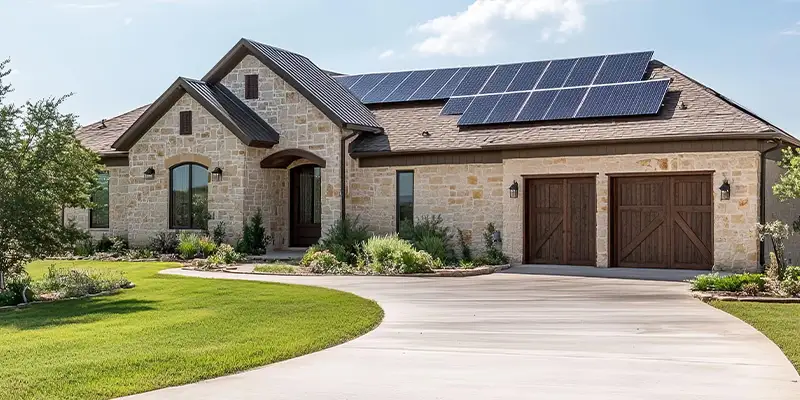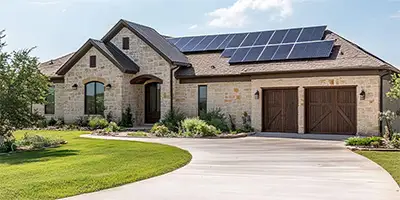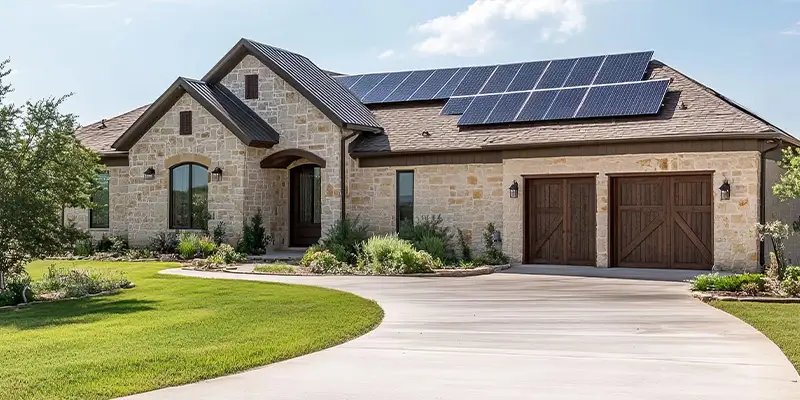Can solar panels power your entire house?
Learn about efficiency, costs, and how many panels you need for full-home energy independence.



Can solar panels power your entire house?
Learn about efficiency, costs, and how many panels you need for full-home energy independence.
The power of the sun
Solar energy is not just about eco-friendly living through avoiding fossil fuels. It's about embracing a source of power that's limitless: the sun's daily rays. Let's dive into how this technology works.
Solar panels are the heart of the solar energy system. They capture sunlight and convert it into electricity. Think of them as your personal power stations, silently working to keep your life energized.
The conversion process
Inside each solar panel are photovoltaic (PV) cells. When sunlight hits these cells, it generates an electric field. This process, known as the photovoltaic effect, is where the real magic happens, transforming daylight into a clean, efficient energy source for your home.
Storage
Solar energy systems often include batteries, meaning you can keep your home powered even when the sun isn't shining. It's like a savings account for energy.
Connecting to the grid
Most homes with solar panels remain connected to the local power grid. This ensures you have electricity when needed and also allows you to send your excess power to the grid, possibly even earning credits on your energy bill.
Solar power in detail
The photovoltaic effect occurs when photons, particles of light, strike the surface of a solar panel. This interaction is the first step in a process that lights up our world.
Semiconductors in solar panels
Solar panels are made of semiconductor materials, typically silicon. When sunlight hits these materials, its energy excites electrons, freeing them from their atomic bonds. These loose electrons are the spark that ignites the flow of electricity.
Current
The freed electrons move toward the front surface of the solar cell, creating a surplus of negative charge. Meanwhile, the back surface accumulates a positive charge. This separation of charges establishes an electric field, much like a battery. When the solar cell is connected to a circuit, this internal electric field drives the flow of electrons, powering your home.
The role of an inverter
The electricity generated is in the form of direct current (DC). However, most homes and appliances use alternating current (AC). Here's where an inverter comes into play. It's small machine that converts DC power into AC power, making the power accessible to everyday appliances.



Solar panels get categorized by size and wattage ratings. The variety gives users some options for designing the best solar system.
Standard size
The most common size for residential solar panels is about 65 inches by 39 inches. Each panel typically produces between 250 to 400 watts of power, depending on the efficiency and technology of the solar cells.
Compact options
For smaller roofs or limited spaces, compact panels are available. These might produce less power, around 150-200 watts, but can more easily fit into tight spaces, ensuring you still generate solar energy.
Typical range
Most home solar panels have wattage ratings between 250 watts to 400 watts per panel. This range accommodates various energy needs and roof sizes, making it easier to customize your solar energy system.
High-efficiency panels, maximizing power output for use in a limited space, can deliver over 400 watts. While they may come with a higher upfront cost, they can offer greater long-term savings and a smaller environmental footprint.
Here's how to identify your home's energy requirements so you can meet that demand with a home solar system.
Understanding your home's energy usage patterns makes a great first step in designing a solar system aligned with your life. Let's break this process down into manageable steps.
Step 1: Gather your energy bills
Your past year's energy bills provide a rich overview of your household's energy consumption across different seasons and personal events.
Step 2: Calculate your average daily energy usage
Step 3: Consider future energy shifts
Think about any upcoming changes that might affect your energy consumption, such as adding an electric vehicle, upgrading appliances or having a child. Adjust your daily average accordingly.
Step 4: Assess sunlight exposure
After you have an estimate of your home’s usage patterns, you can go on to calculate the number of panels that would cover that need.
According to the U.S. Department of Energy, federal tax credits are available for homes in Texas installing solar.
Homes that are buying solar systems can receive a tax credit of 30% of their costs. Those costs include:
Solar power is revolutionizing how we think about energy, but it’s also a somewhat recent development for household use. That means misconceptions crop up.
Let's shine a light on some common myths about solar power.
Reality: While it's true that solar panels operate at peak efficiency in direct sunlight, they can still generate significant energy on overcast days. Advances in technology mean that solar panels can capture different parts of the solar spectrum, so even when it's not bright and sunny, your panels are hard at work.
Reality: The cost of solar energy has plummeted in recent years, making it more accessible. With various financing options, incentives, and rebates available, going solar is an increasingly affordable choice for homeowners. Plus, the savings on your energy bill can offset the initial investment over time.
Reality: Once installed, solar panels need little more than an occasional cleaning to ensure they operate efficiently. Most solar panels are also backed by long-term warranties, providing peace of mind for the long term.
Reality: When installed professionally, solar panels can actually protect and preserve the portion of the roof they cover. Installers take great care to ensure the integrity of your roof is maintained or even improved.
Reality: Improvements in solar technology have impacted panel efficiency and the constituent parts of a solar system. With the ability to store excess energy in solar batteries, solar power can keep your home running day and night.



Understanding the solar investment
The cost of solar panels can vary widely depending on several factors, including the size of your system, the type of panels you choose and the installation. On average, homeowners in Texas can expect to pay between $11,000 and $14,000 for a solar panel system after federal tax credits. A good way to think of this cost is as an investment that pays off over time through savings on your electricity bills.
Solar panels
The cost of solar panels can vary based on their efficiency, brand and size. On average, you can expect to pay between $0.70 and $1.50 per watt. For a typical home system, this translates to about $3,500 to $7,000 for the panels themselves.
Inverters
Inverters play a crucial role in your solar system by converting the direct current (DC) electricity generated by your panels into the alternating current (AC) electricity used in your home. The price for inverters can range from $1,000 to $1,500, depending on the system's size and the inverter technology.
Mounting systems: the support structure
Mounting systems securely attach your solar panels to your roof or the ground. The cost for these systems can vary widely, typically ranging from $500 to $2,000, influenced by the mounting location and the complexity of the installation.
Additional components
Beyond the primary components, there are additional costs to consider, including wiring, electrical components and labor. These can add another $1,000 to $3,000 to your total investment.
Incentives from state and federal government programs are frequently available to defray the costs of solar systems and installation.
Federal Solar Investment Tax Credit (ITC)
One of the most significant incentives for solar energy nationwide is the Federal Solar Investment Tax Credit (ITC). This incentive allows you to deduct a percentage of your solar system's cost from your federal taxes. For example, the ITC has been a 26% tax credit for systems installed before the end of 2022, which then shifted to 22% for systems installed in 2023.
A thorough internet search can turn up current ITC terms.
Local utility rebates
Many local utilities in Texas offer rebates for homeowners who choose to install solar panels. These rebates can significantly reduce the upfront cost of going solar. Rebate programs vary by utility provider, so it's essential to check with your local provider to see what incentives are available in your area.
Property tax exemption
At times, Texas offers a property tax exemption for solar panel installations. This means that the added value to your home from installing a solar energy system won't increase your property taxes.
Net metering programs
Some utilities in Texas offer net metering programs, allowing a solar system owner to sell any excess electricity their home generates back to the grid, often at the same rate the utility charges for electricity in the first place. This can further reduce energy bills and increase the financial benefits of going solar.
Ready to find your Reliant electricity plan?
Start shopping!
Select a category from the dropdown menu.